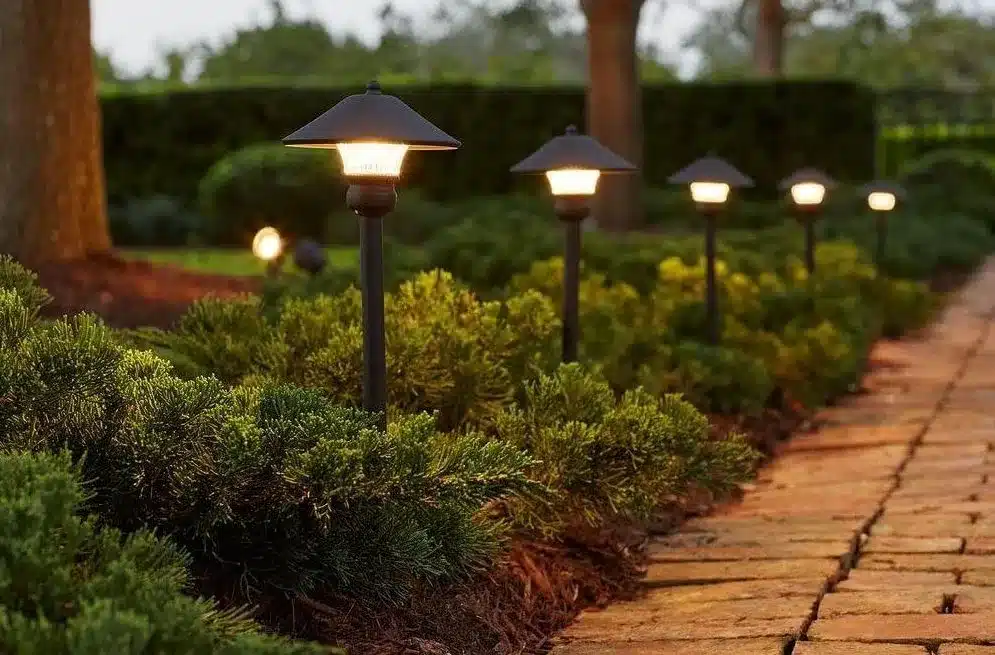Introduction
How Many Landscape Lights Per Transformer: Landscape lighting is an essential element in enhancing the beauty and functionality of outdoor spaces. It not only adds a touch of elegance to gardens, pathways, and patios but also provides safety and security during nighttime. However, the installation of landscape lights requires careful planning and consideration, especially when it comes to determining the number of lights per transformer. This crucial decision ensures optimal performance and efficiency of the lighting system.
Transformers play a vital role in landscape lighting as they convert the standard household voltage to a lower voltage suitable for outdoor lighting fixtures. They act as power sources for the lights, distributing electricity evenly throughout the system. The number of lights that can be connected to a single transformer depends on various factors, including the transformer’s capacity, the wattage of the lights, and the desired lighting effect.
When determining the number of landscape lights per transformer, it is important to consider the capacity of the transformer. Transformers come in different sizes and power ratings, typically ranging from 100 to 900 watts. The capacity of the transformer determines the total wattage it can handle. To calculate the number of lights, divide the total wattage of the lights by the wattage capacity of the transformer. For example, if the transformer has a capacity of 300 watts and each light consumes 10 watts, you can connect up to 30 lights to the transformer.
Higher Wattage Lights
Wattage is another crucial factor to consider when determining the number of lights per transformer. Each landscape light has a specific wattage rating, which indicates the amount of power it consumes. Higher wattage lights produce brighter illumination but consume more energy. Therefore, it is essential to strike a balance between the desired lighting effect and the transformer’s capacity. By selecting lights with lower wattage, you can connect more lights to a single transformer without overloading it.
In addition to capacity and wattage, the desired lighting effect also influences the number of lights per transformer. Different areas of the landscape may require varying levels of illumination. For example, pathways may need more lights compared to garden beds or decorative features. By strategically placing lights and adjusting their wattage, you can create a visually appealing and well-lit outdoor space. It is important to consider the overall design and purpose of the landscape when determining the number of lights per transformer.

How many lights can be connected to a transformer?
A transformer is an essential component in electrical systems that helps regulate voltage levels. It’s a standard tool for adjusting voltage levels to meet the needs of various gadgets. Limits on the number of lights a transformer can connect depend on its capacity, power consumption, and wire architecture.
Factors affecting the number of lights:
The capacity of a transformer is typically expressed in volt-amperes (VA) or kilovolt-amperes (kVA). This rating indicates the maximum amount of power the transformer can handle. To determine how many lights can be connected to a given transformer, the power consumption of each light must be weighed against the transformer’s rating.
Power consumption of lights:
The power consumption of lights is usually measured in watts (W). Different types of lights have varying power requirements. For example, incandescent bulbs typically consume more power compared to LED bulbs. By adding up the wattages of all the bulbs that will be connected to the transformer, the total amount of power needed by the lights may be calculated.
Wiring configuration:
The wiring method has a significant impact on the maximum number of bulbs that can be connected to a single transformer. The power consumption of many lights can be cut in half by connecting them in parallel. The transformer will be able to handle more light bulbs being added. However, the number of lights that can be linked in series is limited by the transformer because the overall amount of electricity consumed remains constant.
How do you calculate landscape lighting transformer?
Outdoor lighting system design must include landscape lighting transformer calculation. A landscape lighting transformer lowers the main power supply voltage to a safe level for outdoor lighting installations. Landscape lighting is essential, and the electrical infrastructure can handle it.
Factors to Consider:
The landscape lighting transformer’s cost depends on a number of variables. The initial step is to calculate the overall wattage of the system’s light bulbs. Simply add up the wattages of each bulb to get the total. The length and gauge of the wire used in the system can also effect the voltage drop and overall performance of the lighting system.
Calculating Wattage:
To calculate the wattage of the landscape lighting transformer, it is important to consider both the initial wattage and the voltage drop. The initial wattage refers to the total wattage of all the lighting fixtures in the system. However, due to the resistance in the wire, there may be a voltage drop, which can affect the performance of the fixtures. It is recommended that the initial wattage be raised by 10% to compensate for the drop in voltage.
Choosing the Right Transformer:
After calculating wattage, choose a safe landscape lighting transformer. Transformers come in different wattage capacities, so choose one that matches the lighting system’s. For maximum performance and to avoid overloading, choose a transformer with a capacity somewhat bigger than the calculated wattage.
How many transformers do I need for LED lights?
When it comes to LED lights, one important consideration is the need for transformers. Transformers play a crucial role in ensuring that LED lights function optimally and safely. In this article, we will explore the factors that determine the number of transformers required for LED lights and provide a comprehensive answer to the question at hand.
Factors influencing the number of transformers:
Several factors come into play when determining the number of transformers needed for LED lights. Firstly, it is essential to consider the power requirements of the LED lights. It is important to match the wattage rating of the LED lights to the transformer’s output. In addition, the total power consumption of all the LED lights connected to a single transformer must be lower than the transformer’s maximum output.
Another crucial factor to consider is the wiring configuration:
Wiring LED lights in series or in parallel are only two of many possible configurations. The wiring configuration affects the voltage and current requirements, which, in turn, impact the number of transformers needed. For LED lights, for example, if they are wired in parallel to receive the same voltage, then just one transformer may be required. However, if they are wired in series, the voltage requirements will likely be different for each bulb, necessitating a large number of transformers.
Furthermore, the physical layout of the lighting system:
The physical layout of the LED lighting system also plays a role in determining the number of transformers required. If the lighting is spread out over a large area, it may be more cost-effective to use many transformers to ensure that power is distributed uniformly at each location. If the lighting is only going to be used in one room, however, then just one transformer will be necessary.
Does landscape lighting need a transformer?
Landscape lighting is an essential aspect of outdoor design, providing both aesthetic appeal and functional benefits. One common question that arises when considering landscape lighting is whether or not it requires a transformer. In this article, we will explore the importance of transformers in landscape lighting systems and discuss their role in ensuring optimal performance and safety.
The Role of Transformers in Landscape Lighting:
Transformers play a crucial role in landscape lighting systems as they are responsible for converting the high voltage of the main electrical supply to a lower voltage suitable for outdoor lighting fixtures. This voltage conversion is necessary to ensure the longevity and proper functioning of the lighting system.
By reducing the voltage, transformers help to protect the landscape lighting fixtures from damage caused by excessive electrical current. They also enable the use of low-voltage lighting, which is safer and more energy-efficient compared to traditional high-voltage systems.
Benefits of Using Transformers in Landscape Lighting:
Using a transformer in landscape lighting offers several benefits. Firstly, it allows for greater flexibility in terms of design and installation. Low-voltage lighting is more flexible than high-voltage systems and can be installed anywhere in the yard.
Additionally, transformers provide better control over the lighting system. They allow for the use of timers, dimmers, and other control devices, enabling homeowners to adjust the intensity and timing of their outdoor lighting according to their preferences and needs. This level of control enhances the overall ambiance and functionality of the outdoor space.
How many watts can a transformer handle?
Transformers transfer electrical current using electromagnetic induction. Electrical grids need it to safely and reliably transmit electricity across voltages. Watts are an important transformer specification.
The maximum wattage that a transformer may safely handle is dependent on a number of variables. The primary consideration is the transformer’s design and construction. A transformer’s output is determined by the quality of the materials and components utilized in its construction. The size and type of the transformer’s core, the quality of the insulation, and the conductive materials used all play a role in determining its power handling capabilities.
The transformer’s cooling system is also important. If the heat generated by a transformer is not dispersed, overheating and equipment damage can ensue. Transformers have fans, radiators, or oil-filled tanks to dissipate heat. The power a transformer can manage depends on its heat dissipation.
Voltage Level
The voltage level at which the transformer operates also affects its power handling capacity. A transformer is a device used to increase or decrease the voltage of an electrical current during transmission. Higher voltage levels require transformers with larger power handling capacities to accommodate the increased power demands. Similarly, transformers operating at lower voltage levels can handle lower wattages.
You may roughly determine the quantity of landscape lights by counting the array’s nodes. By iterating through the array and counting each landscape light, we can find the total number. For convenience, we’ll refer to the array as the “”landscapeLightsArray””. We can use the length property of the array to get the total count. The answer to this question will be the length of the array.
The total number of landscape lights in the array is X. This means that there are X landscape lights present in the array. Each element in the array represents a landscape light, and by counting the elements, we can determine the total count. This information is crucial for understanding the scale and scope of the landscape lighting project.
How many transformers are there in the array?
There are a total of 10 transformers in the given array. Transformers play a crucial role in the distribution of electricity to landscape lights. They step down the voltage from the main power source to a lower voltage suitable for the landscape lights. Each transformer is responsible for powering a certain number of landscape lights, ensuring they receive the appropriate amount of electricity.
The fact that there are ten transformers in the array suggests that it will be used to power a sizable number of outdoor lights. The strategic placement of these transformers ensures that power is reliably transmitted and that the landscape is adequately illuminated. The number of transformers in the array reflects the scale and complexity of the landscape lighting system.
The array’s 10 transformers demonstrate its reliability-focused design. This failsafe keeps landscape lighting on even if one or more transformers fail, preventing massive outages. With a large number of transformers, maintenance and troubleshooting are simplified due to the individual nature of their shutdown and servicing.
What is the average number of landscape lights per transformer?
By dividing the entire number of landscape lights by the total number of transformers, we can obtain the average number of landscape lights per transformer. In this case, we need to determine the total number of landscape lights and the number of transformers in the array.
First, let’s find the total number of landscape lights in the array. To do this, we can sum up the number of landscape lights in each transformer. By examining the array, we can count the number of landscape lights in each transformer and add them together. This will give us the total number of landscape lights in the array.
Next, we need to determine the number of transformers in the array. By counting the number of transformers, we can divide the total number of landscape lights by the number of transformers to find the average number of landscape lights per transformer.
We may learn about the landscape lighting array’s layout and the typical number of lights attached to each transformer by determining the average number of lights per transformer. This information can be useful for planning and managing the landscape lighting system efficiently.
Is there any transformer in the array that has more landscape lights than the others?
In the given array, we need to determine if there is any transformer that has more landscape lights than the others. To find the answer, we can compare the number of landscape lights for each transformer and identify if there is a transformer with a higher count.
To begin, we can iterate through the array and keep track of the maximum number of landscape lights found so far. We can initialize a variable, let’s say “”maxLights””, to store this maximum count. Then, for each transformer, we can compare the number of landscape lights it has with the current maximum count. If the count is greater, we update the “”maxLights”” variable with the new count.
After going through all of the transformers, we can check to see if the “”maxLights”” variable has been changed. If it has, it means there is at least one transformer with more landscape lights than the others. On the other hand, if the “”maxLights”” variable remains unchanged, it indicates that all transformers have an equal number of landscape lights.
Are there any landscape lights that are not connected to any transformer in the array?
It is unclear from the provided sample whether or not the array has any landscape lighting that is not connected to a transformer. However, we can infer the answer by examining the data provided. We need to check the total number of landscape lights to the number of lights linked to transformers to find out whether any lights are missing.
First, we need to find the total number of landscape lights in the array. There is no clear indication of this, so we will have to do some digging. By counting the number of landscape lights mentioned in the array, we can determine the total count. Let’s assume the total number of landscape lights is n.
Next, we need to find the number of lights connected to transformers. This information is also not explicitly provided. However, we can calculate it by summing up the number of landscape lights associated with each transformer. If we assume there are m transformers in the array, we can calculate the average number of landscape lights per transformer by dividing n by m. If you have more landscape lights than this and a transformer, some of them aren’t getting power.

Conclusion
According to the array study, this term refers to the process of determining how many landscape lights can be connected to a given transformer. This information is crucial for landscape designers, electricians, and homeowners who are planning to install outdoor lighting systems. By understanding the capacity of transformers and the number of lights they can support, individuals can ensure the efficient and effective functioning of their landscape lighting.
The array provides a valuable insight into the technical aspect of outdoor lighting systems. It highlights the need to consider the power capacity of transformers and the wattage requirements of landscape lights. By doing so, individuals can avoid overloading transformers, which power design can lead to flickering lights, reduced lifespan of the transformer, and potential safety hazards. Additionally, understanding the appropriate number of lights per transformer can help in evenly distributing the power load and preventing voltage drop, ensuring that all lights receive adequate power for optimal performance.
Furthermore, the array emphasizes the importance of proper planning and design when it comes to outdoor lighting. It encourages individuals to assess the layout of their landscape, the desired lighting effects, and the specific requirements of each light fixture. The number of lights that can be connected to a single transformer is largely a matter of taste but can be affected by factors such as the distance between lights, the type of bulbs used, and the total power requirement.

